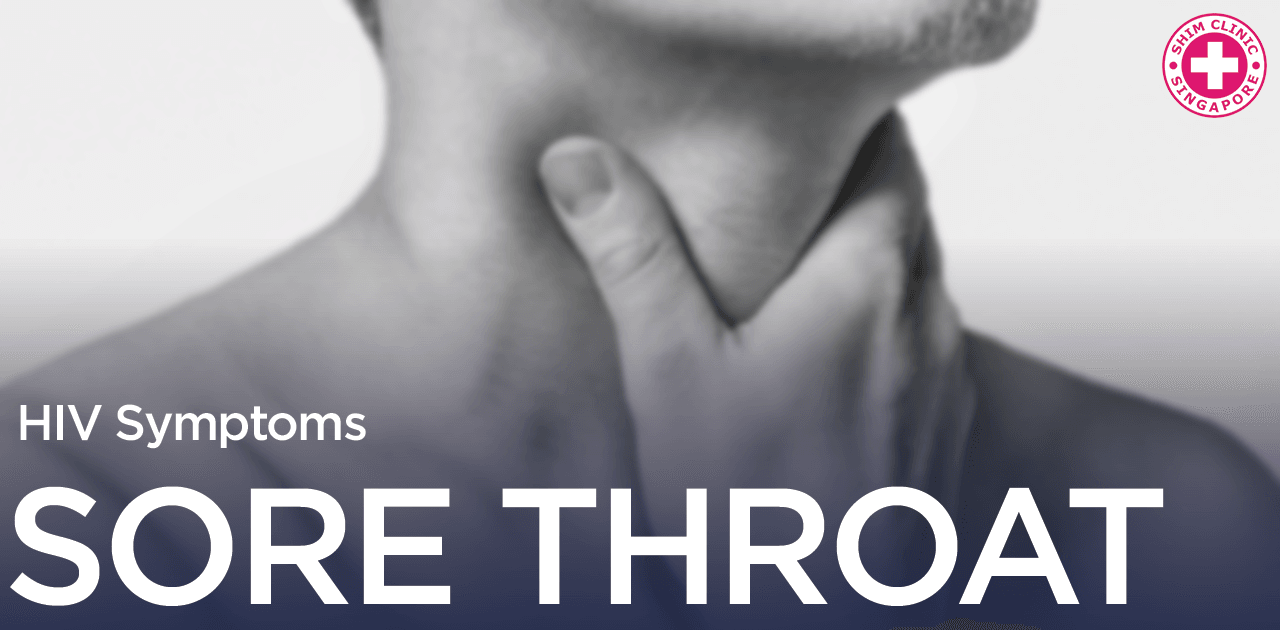HIV Sore Throat Singapore | Shim Clinic
| Help me about HIV Sore Throat ! |

| Permalink: https://shimclinic.sg/hiv-sore-throat |
Many people know that HIV has a long latency period during which it has no symptoms, but may not know that there is also a period of symptoms shortly after the infection begins. Starting 2 to 4 weeks after exposure, people may have sore throat, fever, rash, nausea, and other flu-like symptoms.
Many people know that HIV can linger in the body undetected for years. There is a long period of time after the infection is acquired during which there are no symptoms; this called the latency period. However, not everyone is aware that there can actually be a period of symptoms before the beginning of the latency period. This is known as acute HIV infection, primary HIV infection, or seroconversion illness. It begins 2 to 4 weeks after the exposure, and can continue for weeks. Although not everyone experiences symptoms during this phase, many people do, although they tend to attribute their symptoms to something else and don’t realize that they actually have HIV.
One symptom of HIV that’s easily overlooked is pharyngitis, which is the medical name for a sore throat. Many people believe that their throat soreness is due to an infection like tonsilitis (often known as “strep throat,” although it’s not always due to the streptococcus bacteria). Others may attribute their throat pain to allergies, irritation from smoking, or another cause. The symptoms of acute HIV infection, including sore throat, can last for up to several weeks.
- Many people know that HIV has a long latency period during which it has no symptoms, but may not know that there is also a period of symptoms shortly after the infection begins.
- Beginning 2 to 4 weeks after exposure, a variety of flu-like symptoms may occur, including sore throat.
- It’s easy to misattribute a sore throat to an infection such as tonsilitis, or to allergies or another cause.
- To check whether sore throat is actually a result of acute HIV infection, you need to get an HIV test. If you don’t tell your doctor about any potential HIV exposures, he or she may not do the test.
- You can prevent HIV with a medication regimen called HIV PEP, but it must be started within 72 hours of exposure. If you have symptoms, it’s too late for HIV PEP.
Because there are so many potential causes of sore throat, it’s not always easy to determine that acute HIV infection is the cause. The extended duration of the symptoms may be a clue, but it’s not possible to diagnose HIV without an HIV test. When you go to your doctor to discuss your potential HIV symptoms, you should also mention any exposures that you may have had (such as a broken condom), so your doctor knows that acute HIV infection is possible and that an HIV test is necessary.
There is a way to prevent HIV after you’re exposed. This is a medication regimen called HIV PEP. It must be started within 72 hours after the exposure occurs, so you can’t wait until you have HIV symptoms, because then it will be too late. If you have an unexpected exposure to HIV, visit an STD clinic as soon as you can, to discuss whether you’re a candidate for HIV PEP.
Sources:
Mayo Clinic. “STD symptoms: Common STDs and their symptoms.” Mayo Clinic. Published 18 Mar 2015. Accessed 20 Jul 2016. http://www.mayoclinic.org/std-symptoms/art-20047081
Centers for Disease Control and Prevention. “Screening Recommendations Referenced in Treatment Guidelines and Original Recommendation Sources.” Centers for Disease Control and Prevention. Published 04 Jun 2015. Accessed 20 Jul 2016. http://www.cdc.gov/std/tg2015/screening-recommendations.htm
Centers for Disease Control and Prevention. “HIV/AIDS.” Centers for Disease Control and Prevention. Published 05 Jul 2016. Accessed 27 Jul 2016. http://www.cdc.gov/hiv/
Centers for Disease Control and Prevention. “HIV Basics – Testing.” Centers for Disease Control and Prevention. Published 12 Jul 2016. Accessed 20 Jul 2016. http://www.cdc.gov/hiv/basics/testing.html
U.S. Department of Health & Human Services. “Post-Exposure Prophylaxis (PEP).” AIDS.gov. Published 21 Sep 2015. Accessed 20 Jul 2016. https://www.aids.gov/hiv-aids-basics/prevention/reduce-your-risk/post-exposure-prophylaxis/
| Timeline | HIV | STD | Pregnancy |
|---|---|---|---|
| Before exposure | |||
| Contraception (females only) | |||
| HIV PrEP (pre-exposure prophylaxis) - Stop HIV infection before exposure | STD vaccine: - Hepatitis vaccine - HPV vaccine | ||
| STD / HIV exposure | |||
| 0-72 hours | HIV PEP (post-exposure prophylaxis) - Stop HIV infection after exposure | STD testing * - Screening test - to look for asymptomatic infections - from previous exposures | Emergency contraception with the morning-after pill (females only) |
| 2 weeks | HIV DNA Test | ||
| 1 month | HIV 4th Generation Test - SD Bioline HIV Ag/Ab Combo - Fingerprick blood sampling. - 20 minutes to results | ||
| 3 months | HIV 3rd Generation Test - OraQuick® HIV-1/2 Antibody - Oral fluid or - Fingerprick blood sampling. - 20 minutes to results | STD testing * - Full & comprehensive - diagnostic test - to look for current infections | |
| Watch for | HIV Symptoms | STD Symptoms | |
| If infected | HIV Treatment | STD Treatment | Abortion |
References